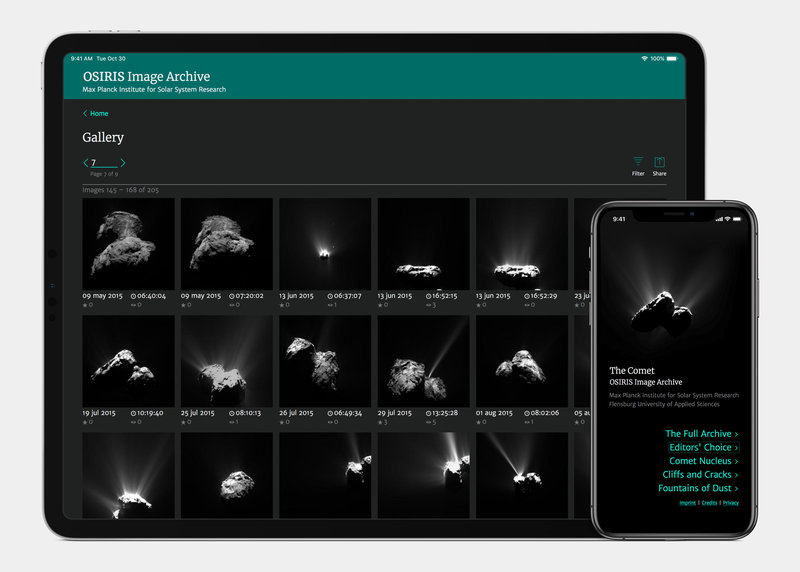Between 2014 and 2016, the scientific camera system OSIRIS onboard ESA’s Rosetta spacecraft captured almost 70000 images of comet 67P/Churyumov-Gerasimenko. They not only document the most extensive and demanding comet mission to date, but also show the duck-shaped body in all its facets. In a joint project with the Department of Information and Communication at Flensburg University of Applied Sciences, the Max Planck Institute for Solar System Research (MPS), head of the OSIRIS team, has now published all of these images. The OSIRIS Image Viewer is suited to the needs of both laymen and expert and offers quick and easy access to one of the greatest scientific treasures of recent years.
The first view of comet 67P/Churyumov-Gerasimenko was captured by the OSIRIS camera system in March 2014 from a distance of almost five million kilometres: an unspectacular starry sky in which only experts can identify one of the numerous bright spots as the target of the Rosetta mission. The mission’s last snapshot was taken on 30 September 2016, just a few minutes before the spacecraft touched down on the comet. Only 20 meters separate the stony surface visible in it from the spacecraft. Between these two images lies an adventure: a space mission that for the first time accompanied a comet on its way through the inner solar system and observed it from close up.
This adventure can now be retraced in detail with the help of the OSIRIS Image Viewer. Browsing through the archive, users will find snapshots taken while Rosetta was still approaching the already awakening comet, images obtained from Philae’s landing, the fireworks of dust and gas emissions during the comet’s perihel passage, and pictures documenting the feverish search for Philae’s landing site during the mission’s final weeks. The images show rugged cliffs, bizarre cracks and gorges, powdery-smooth plains and boulder-covered fields as well as spectacular jets of dust and gas in the vicinity of the comet’s nucleus.
"It is important to us that this treasure trove of data is easily accessible to everyone. No prior knowledge is necessary”, explains MPS scientist Dr. Holger Sierks, OSIRIS Principal Investigator. In close cooperation with students and lecturers from the Department of Information and Communication at the University of Applied Sciences Flensburg, the MPS scientists have designed the viewer in such a way that all images and additional information can be found quickly. Each of the almost 70,000 images is supplemented with the date on which it was taken, the distance to the comet, and a short accompanying text and can be downloaded in full resolution. For users who wish to delve deeper or use the archive for scientific purposes, the images are also available in scientific data format; in addition, there is information available on the filters used, focal lengths, and exposure times as well as references to the scientific documentation and evaluation software.
Since June 2018, also the ESA Archive Image Browser and ESA's Planetary Science Archive have been providing all images and data from the Rosetta mission online. “ESA's databases are primarily aimed at scientists," Sierks says. "We see the OSIRIS Image Viewer as a supplement to these services. It is designed to be easily accessible and appealing for everyone - and above all show the comet in all its beauty," he adds.
Contact
Dr. Birgit Krummheuer
Press Office
Phone:+49 551 384979-462
Email: presseinfo@mps.mpg.de
Dr. Holger Sierks
OSIRIS Principal Investigator
Phone:+49 551 384979-242
Email: sierks@mps.mpg.de
Sascha Reinhold
Flensburg University of Applied Sciences, Department of Information and Communication
Phone:+49 461 805-1659
Email: sascha.reinhold@hs-flensburg.de


